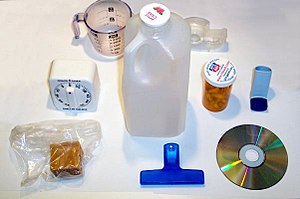
Back Plastiek Afrikaans Kunststoff ALS Plastico AN لدائن Arabic پلاستيك ARY প্লাষ্টিক Assamese Plásticu AST Plastmas Azerbaijani پیلاستیک AZB Пластмассалар Bashkir

Plastics are a wide range of synthetic or semisynthetic materials that use polymers as a main ingredient. Their plasticity makes it possible for plastics to be molded, extruded, or pressed into solid objects of various shapes. This adaptability, combined with a wide range of other properties, such as being lightweight, durable, flexible, nontoxic, and inexpensive to produce, has led to their widespread use around the world.[1] Most plastics are derived from natural gas and petroleum, and a small fraction from renewable materials. One such material polylactic acid.[2]
Between 1950 and 2017, 9.2 billion metric tons of plastic are estimated to have been made; more than half of this has been produced since 2004. In 2023, preliminary figures indicate that over 400 million metric tons of plastic were produced worldwide.[3] If global trends on plastic demand continue, it is estimated that annual global plastic production will reach over 1.3 billion tons by 2060.[3] Major applications include packaging (40%) and building/construction (20%).[1]
The success and dominance of plastics since the early 20th century has had major benefits for mankind, ranging from medical devices to light-weight construction materials. The sewage systems in many countries relies on the resiliency and adaptability of polyvinyl chloride. It is also true that plastics are the basis of widespread environmental concerns,[4] due to their slow decomposition rate in natural ecosystems. Most plastic produced has not been reused. Some is unsuitable for reuse. Much is captured in landfills or as plastic pollution. Particular concern focuses on microplastics. Marine plastic pollution, for example, creates garbage patches. Of all the plastic discarded so far, some 14% has been incinerated and less than 10% has been recycled.[5]
In developed economies, about a third of plastic is used in packaging and roughly the same in buildings in applications such as piping, plumbing or vinyl siding.[6] Other uses include automobiles (up to 20% plastic[6]), furniture, and toys.[6] In the developing world, the applications of plastic may differ; 42% of India's consumption is used in packaging.[6] Worldwide, about 50 kg of plastic is produced annually per person, with production doubling every ten years.
The world's first fully synthetic plastic was Bakelite, invented in New York in 1907, by Leo Baekeland,[7] who coined the term "plastics".[8] Dozens of different types of plastics are produced today, such as polyethylene, which is widely used in product packaging, and polyvinyl chloride (PVC), used in construction and pipes because of its strength and durability. Many chemists have contributed to the materials science of plastics, including Nobel laureate Hermann Staudinger, who has been called "the father of polymer chemistry", and Herman Mark, known as "the father of polymer physics".[9]
- ^ a b Elias, Hans-Georg; Mülhaupt, Rolf (2015). "Plastics, General Survey, 1. Definition, Molecular Structure and Properties". Ullmann's Encyclopedia of Industrial Chemistry. pp. 1–70. doi:10.1002/14356007.a20_543.pub2. ISBN 978-3-527-30673-2.
- ^ "Life Cycle of a Plastic Product". Americanchemistry.com. Archived from the original on March 17, 2010. Retrieved July 1, 2011.
- ^ a b "Global plastic production with projections, 1950 to 2060". Our World In Data. April 13, 2023. Retrieved January 6, 2025.
- ^ "The environmental impacts of plastics and micro-plastics use, waste and pollution: EU and national measures" (PDF). europarl.europa.eu. October 2020.
- ^ Environment, U. N. (October 21, 2021). "Drowning in Plastics – Marine Litter and Plastic Waste Vital Graphics". UNEP - UN Environment Programme. Retrieved March 21, 2022.
- ^ a b c d Cite error: The named reference
Applicationswas invoked but never defined (see the help page). - ^ American Chemical Society National Historic Chemical Landmarks. "Bakelite: The World's First Synthetic Plastic". Retrieved February 23, 2015.
- ^ Edgar D, Edgar R (2009). Fantastic Recycled Plastic: 30 Clever Creations to Spark Your Imagination. Sterling Publishing Company, Inc. ISBN 978-1-60059-342-0 – via Google Books.
- ^ Teegarden DM (2004). Polymer Chemistry: Introduction to an Indispensable Science. NSTA Press. ISBN 978-0-87355-221-9 – via Google Books.